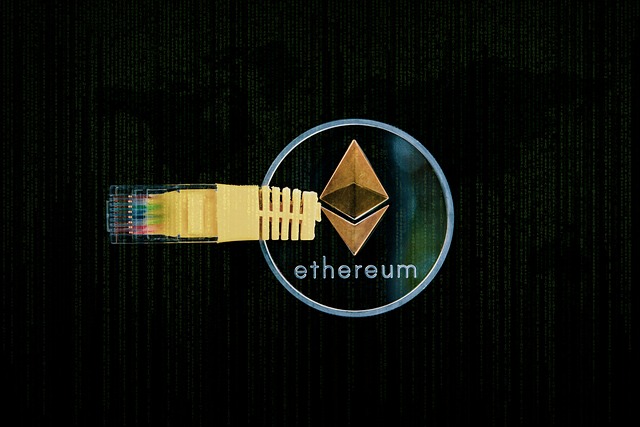
Ethereum, as a decentralized blockchain network, has become a leading force in Decentralized Finance (DeFi), powered by its smart contract technology. It facilitates lending, borrowing, and trading through its native cryptocurrency, Ether (ETH). Ethereum's open-source architecture allows developers to create decentralized applications (dApps), contributing to a global DeFi ecosystem. Lending and borrowing on Ethereum through platforms like Uniswap, Compound, Aave, MakerDAO, and Yearn.finance offer peer-to-peer transactions with enhanced transparency and security. However, challenges include complex platforms, smart contract vulnerabilities, and regulatory uncertainty. The future of Ethereum's DeFi sector is promising due to technological advancements, increased participation, and upcoming upgrades like Ethereum 2.0, aiming to foster global financial inclusion.
Dive into the dynamic world of Ethereum-powered decentralized finance (DeFi) and explore how lending and borrowing have revolutionized the financial landscape. This article unravels the intricacies of Ethereum’s role in facilitating peer-to-peer transactions, offering secure and transparent alternatives to traditional banking. From understanding the blockchain’s fundamentals to uncovering popular DeFi platforms, we demystify the process, highlight benefits and risks, and glimpse into the future of this burgeoning sector, all centered around Ethereum.
- Understanding Ethereum and its Role in Decentralized Finance (DeFi)
- The Basics of Lending and Borrowing on Ethereum Blockchain
- Popular DeFi Platforms for Ethereum-Based Lending/Borrowing
- Advantages, Risks, and Regulatory Considerations in DeFi Lending/Borrowing
- Future Prospects and Innovations in Ethereum's DeFi Space
Understanding Ethereum and its Role in Decentralized Finance (DeFi)

Ethereum, often referred to as a decentralized blockchain network, has emerged as a pivotal player in the realm of Decentralized Finance (DeFi). Its innovative smart contract technology enables seamless and transparent transactions without the need for intermediaries. In the context of DeFi, Ethereum serves as the backbone infrastructure, facilitating various financial applications such as lending, borrowing, trading, and more.
The network’s native cryptocurrency, Ether (ETH), plays a crucial role in these activities. Users can lend or borrow ETH, engaging in decentralized money markets where supply and demand dynamically set interest rates. This open-source nature of Ethereum allows developers to build and deploy decentralized applications (dApps) on top of the platform, fostering a thriving ecosystem of DeFi platforms that offer innovative financial services accessible to anyone with an internet connection.
The Basics of Lending and Borrowing on Ethereum Blockchain

Lending and borrowing on the Ethereum blockchain, powered by Decentralized Finance (DeFi) platforms, represent a revolutionary shift in financial services. Users can now participate in open-ended lending pools, where they deposit cryptocurrency assets and earn interest while others borrow funds from these pools, securing loans with collateral. This peer-to-peer system, facilitated by smart contracts, eliminates the need for traditional intermediaries like banks.
The Ethereum blockchain’s transparency, security, and global accessibility make it an ideal environment for DeFi lending and borrowing. Smart contracts automatically enforce loan agreements, ensuring fairness and accuracy in transactions. Users can borrow against a variety of crypto assets, including stablecoins, offering flexible financial options. This innovative approach to finance is rapidly gaining traction, attracting investors and borrowers worldwide who seek greater control, lower fees, and faster access to capital using the Ethereum ecosystem.
Popular DeFi Platforms for Ethereum-Based Lending/Borrowing

When it comes to popular DeFi platforms for Ethereum-based lending and borrowing, several stand out due to their robust features and user-friendly interfaces. Uniswap is a prominent example, offering a decentralized exchange that also facilitates lending and borrowing through its V2 protocol. Compound is another leading platform, known for its innovative smart contracts that allow users to earn interest on deposits and borrow assets with collateral. Aave is worth mentioning too, as it provides advanced lending and borrowing options, including synthetic assets, making it appealing for both individual investors and institutions.
Additionally, MakerDAO has gained significant traction for its stablecoin, DAI, which is backed by Ethereum-based collateral. This platform allows users to borrow DAI while locking up their ETH in a vault, ensuring price stability. Other notable mentions include Yearn.finance, which offers various yield farming and lending products, and SushiSwap, a decentralized exchange that also supports lending pools, providing users with multiple avenues for earning and borrowing on the Ethereum blockchain.
Advantages, Risks, and Regulatory Considerations in DeFi Lending/Borrowing

The decentralized finance (DeFi) ecosystem on Ethereum offers a revolutionary approach to lending and borrowing, providing users with unprecedented access and control over their funds. One of the key advantages is the elimination of intermediaries, allowing direct peer-to-peer transactions. This not only reduces costs but also enhances transparency, as all agreements and transactions are recorded on a public blockchain. Users can earn interest on their deposits or borrow assets with minimal collateral, opening up opportunities for both savers and borrowers.
However, alongside these benefits, there are significant risks to consider. DeFi platforms are often complex and lack traditional regulatory safeguards. Smart contract vulnerabilities and bugs can lead to substantial financial losses, as seen in several high-profile cases. Additionally, the volatile nature of Ethereum’s native cryptocurrency, ETH, exposes borrowers to potential price swings, impacting their ability to repay loans. Regulatory bodies are still grappling with how to classify and regulate DeFi activities, leading to uncertainty for both users and developers. As the space continues to evolve, addressing these risks through improved security measures, user education, and clear regulatory frameworks will be essential to ensure a sustainable and trustworthy Ethereum-based lending and borrowing environment.
Future Prospects and Innovations in Ethereum's DeFi Space

The future of Ethereum’s DeFi space looks promising, with continuous innovations and growing interest from both developers and users. As Ethereum 2.0 progresses, we can expect improved scalability, reduced transaction fees, and enhanced security, all of which will further fuel the growth of decentralized finance applications. The integration of advanced features like zero-knowledge proofs and layer-2 scaling solutions will open up new possibilities for privacy and efficiency in DeFi lending and borrowing.
Additionally, the Ethereum ecosystem is witnessing the rise of innovative protocols that offer dynamic yield farming strategies, enhanced risk management tools, and customizable lending parameters. These developments aim to attract a broader range of users, from casual investors to institutional players, creating a more inclusive and robust DeFi environment. The decentralized nature of Ethereum ensures that these financial services remain accessible and transparent, fostering a new era of financial inclusion and empowerment for individuals worldwide.
Ethereum has revolutionized decentralized finance (DeFi) by providing a robust platform for lending and borrowing activities. This article has explored the fundamentals of Ethereum’s role in DeFi, the intricacies of its blockchain-based lending/borrowing system, and the thriving ecosystem of popular DeFi platforms. We’ve also delved into the benefits, risks, and regulatory challenges that come with this innovative financial model. Looking ahead, Ethereum’s DeFi space is poised for significant growth, driven by technological advancements and a growing user base seeking alternative financial solutions. As this field continues to evolve, staying informed about its dynamics will be key for both participants and regulators alike.






